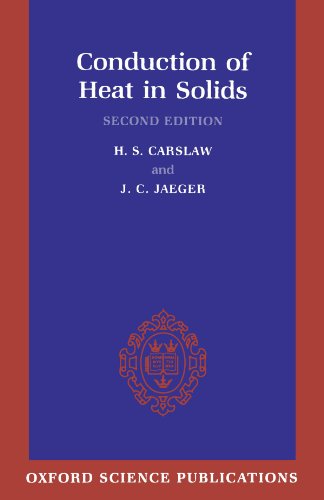Conduction of Heat in Solids book
Par webb lois le vendredi, juin 17 2016, 07:57 - Lien permanent
Conduction of Heat in Solids. H. S. Carslaw, J. C. Jaeger

Conduction.of.Heat.in.Solids.pdf
ISBN: 0198533683,9780198533689 | 517 pages | 13 Mb

Conduction of Heat in Solids H. S. Carslaw, J. C. Jaeger
Publisher: Oxford University Press, USA
An example of conduction through contact between two solids is a cooking pot on the solid surface of a hot stove. Conduction is heat loss that happens between two solids that are in contact with each other. Conduction is heat transfer within solids or between contacting solids. The rate of heat loss on a cross bike will tend to be less than on a road bike, because the speeds are lower. For example, metals are better conductor than wood or plastic. Convection is heat transfer by the movement of liquids or gasses. I am having trouble with a flow simulation for a school senior design project. For example, if one end of a metal rod is heated up, the heat will gradually travel to the other end until the entire rod becomes hot. Gases, such as air, do not conduct heat very well. This is the primary method of heat transfer in solids and it works best of all in metals (because loosely bound electrons play a role). Heat Conduction takes place in solids, liquids, and gases, but works best in materials that have simple molecules that are located close to each other. Conduction is heat transfer from warm to cooler areas within a material, or between two materials touching each other. Well, in fact there are two mechanisms of heat conduction. It is also an efficient method of conduction in liquids, but occurs hardly at all in gases. Even though conduction is specific to solids, this heat transfer mechanism is found at the interaction of two fluids, when they have a laminar flow. All solids (metals and non-metals) are made up of tiny particles called atoms, or groups of atoms called molecules. Introduction to the Mathematical Theory of the Conduction of Heat in Solids book download Download Introduction to the Mathematical Theory of the Conduction of Heat in Solids . Heat Conduction: Lumped System Analysis – Heat Transfer in Semi infinite and infinite solids – Use of Transient – Temperature charts – Application of numerical techniques. The greatest flow of heat possible between materials is where there is a direct conduction between solids. Thermal conduction exists in solids, liquids and gasses. However, there is one important difference between metals and non-metals: metals contain Now, here comes the question: if molecular vibration is common to both metals and non-metals, shouldn't we expect both of them to exhibit similar heat conductivity?